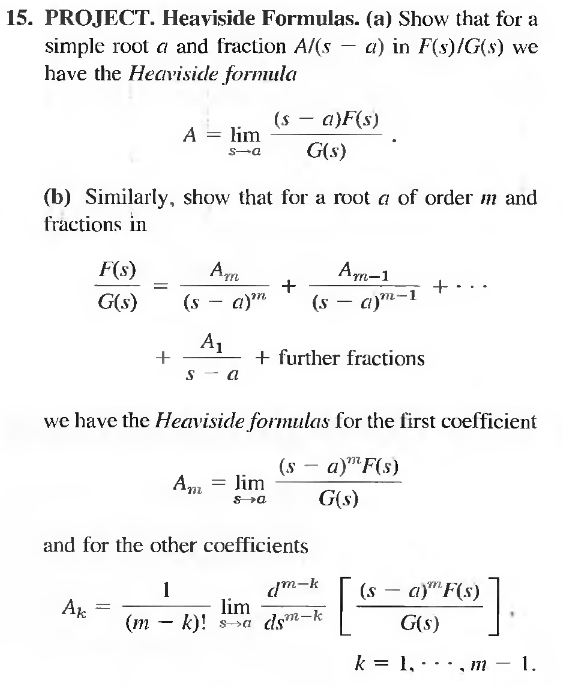|
|
Last edited by hbghlyj 2023-1-31 21:31相关
PlanetMath–Heaviside formula
Let $P(s)$ and $Q(s)$ be polynomials with the degree of the former less than the degree of the latter.
- If all complex zeroes $a_1,a_2,\ldots,a_n$ of $Q(s)$ are simple, then
\begin{align}
\mathcal{L}^{-1}\left\{\frac{P(s)}{Q(s)}\right\} = \sum_{j=1}^n\frac{P(a_j)}{Q'(a_j)}e^{a_jt}.
\end{align} - If the different zeroes $a_1,a_2,\ldots,a_n$ of $Q(s)$ have the multiplicities $m_1,m_2,\ldots,m_n$, respectively,
we denote $F_j(s) := (s-a_j)^{m_j}P(s)/Q(s)$; then
\begin{align}\label2
\mathcal{L}^{-1}\left\{\frac{P(s)}{Q(s)}\right\} =
\sum_{j=1}^ne^{a_jt}\sum_{k=0}^{m_j-1}\frac{F_j^{(k)}(a_j)\;t^{m_j-1-k}}{k!(m_j-1-k)!}.
\end{align}
A special case of the Heaviside formula (1) is
\begin{align}
\mathcal{L}^{-1}\left\{\frac{Q'(s)}{Q(s)}\right\}
= \sum_{j=1}^ne^{a_jt}.
\end{align}
Example. Since the zeros of the binomial $s^4+4a^4$ are $s = (\pm1\pm i)a$, we can calculate by (3) as follows:
$$\mathcal{L}^{-1}\left\{\frac{s^3}{s^4+4a^4}\right\}
= \frac{1}{4}\mathcal{L}^{-1}\left\{\frac{4s^3}{s^4+4a^4}\right\} = \frac{1}{4}\sum_\pm e^{(\pm 1\pm i)at}
= \frac{e^{at}+e^{-at}}{2}\cdot\frac{e^{iat}+e^{-iat}}{2}
= \cosh{at}\cos{at}$$
Proof of (1). Without hurting the generality, we can suppose that $Q(s)$ is monic. Therefore
$$Q(s) = (s-a_1)(s-a_2)\cdots(s-s_n).$$
For $j = 1,2,\ldots,n$, denoting
$$Q(s) := (s-a_j)Q_j(s),$$
one has $Q_j(a_j) \neq 0$. We have a partial fraction expansion of the form
\begin{align}
\frac{P(s)}{Q(s)} = \frac{C_1}{s-a_1}+\frac{C_2}{s-a_2}+\ldots+\frac{C_n}{s-a_n}
\end{align}
with constants $C_j$. According to the linearity and the formula 1 of Laplace Transform, one gets
\begin{align}
\mathcal{L}^{-1}\left\{\frac{P(s)}{Q(s)}\right\}
= \sum_{j=1}^nC_je^{a_jt}.
\end{align}
For determining the constants $C_j$, multiply (3) by $s-a_j$. It yields
$$\frac{P(s)}{Q_j(s)}
= C_j+(s-a_j)\sum_{\nu \neq j}\frac{C_\nu}{s-a_\nu}.$$
Setting to this identity $s := a_j$ gives the value
\begin{align}
C_j = \frac{P(a_j)}{Q_j(a_j)}.
\end{align}
But since $Q'(s) = \frac{d}{ds}((s-a_j)Q_j(s))
= Q_j(s)+(s-a_j)Q_j'(s)$,
we see that $Q'(a_j) = Q_j(a_j)$; thus the equation (6) may be written
\begin{align}
C_j = \frac{P(a_j)}{Q'(a_j)}.
\end{align}
The values (6) in (4) produce the formula (1).
Kreyszig E - Advanced Engineering Mathematics - Wiley 2006 9Ed (工科数学) page 247 Problem 15

| 15. PROJECT. Heaviside Formulas. (a) Show that for a simple root $a$ and fraction $A /(s-a)$ in $F(s) / G(s)$ we have the Heaviside formula
$$
A=\lim _{s \rightarrow a} \frac{(s-a) F(s)}{G(s)} .
$$
(b) Similarly, show that for a root $a$ of order $m$ and fractions in
$$
\frac{F(s)}{G(s)} =\frac{A_m}{(s-a)^m}+\frac{A_{m-1}}{(s-a)^{m-1}}+\cdots +\frac{A_1}{s-a}+\text {further fractions}
$$
we have the Heaviside formulas for the first coefficient
$$
A_m=\lim _{s \to a} \frac{(s-a)^m F(s)}{G(s)}
$$
and for the other coefficients
$$
A_k=\frac{1}{(m-k) !} \lim _{s \to a} \frac{d^{m-k}}{d s^{m-k}}\left[\frac{(s-a)^m F(s)}{G(s)}\right], \quad
k=1, \cdots, m-1 .
$$
|
Heaviside cover-up method
Brilliant wiki
cover-up即 “把分母中的0覆盖”, 在h.pdf把分母中的0填充\phantom, 节录如下:$$\frac{x-7}{(x-1)(x+2)}=\frac{A}{x-1}+\frac{B}{x+2}$$
To determine $A$ by the cover-up method, on the left-hand side we mentally remove (or cover up with a finger) the factor $x - 1 $ associated with $A$, and substitute $x = 1$ into what’s left; this gives $A$:
为了通过覆盖法确定$A$,在左侧,我们在脑中删除(或用手指覆盖)与$A$相关的因子$x - 1$,并将$x = 1$代入剩下的; 这给出 $A$:
$$\left.\frac{x-7}{\hphantom{(x-1)}(x+2)}\right|_{x=1}=\frac{1-7}{1+2}=-2=A$$而在HeavisideCoverup2008.pdf用\box填充. 在第4页介绍了如何对重根使用此方法:
Extension to Multiple Roots. Heaviside’s method can be extended to the case of repeated roots. The basic idea is to factor–out the repeats. To illustrate, consider the partial fraction expansion details
\begin{array}{rlrl}R & =\frac{1}{(s+1)^{2}(s+2)} & & \text {A sample rational function having repeated roots.} \\ & =\frac{1}{s+1}\left(\frac{1}{(s+1)(s+2)}\right) & & \text {Factor–out the repeats.} \\ & =\frac{1}{s+1}\left(\frac{1}{s+1}+\frac{-1}{s+2}\right) & & \text {Apply the cover–up method to the simple root fraction} \\ & =\frac{1}{(s+1)^{2}}+\frac{-1}{(s+1)(s+2)} & & \text {Multiply.} \\ & =\frac{1}{(s+1)^{2}}+\frac{-1}{s+1}+\frac{1}{s+2} & & \text {Apply the cover–up method to the last fraction on the right.}\end{array}Special Methods. Heaviside’s method has a useful extension for the case of roots of multiplicity two. To illustrate, consider these details:
\begin{array}{rll} R & =\frac{1}{(s+1)^{2}(s+2)} &\boxed1\text{A fraction with multiple roots.}\\ & =\frac{A}{s+1}+\frac{B}{(s+1)^{2}}+\frac{C}{s+2} &\boxed2\text{ See equation (5), page 2.}\\ & =\frac{A}{s+1}+\frac{1}{(s+1)^{2}}+\frac{1}{s+2}&\boxed3\text{ Find $B$ and $C$ by Heaviside’s cover–up method.} \\ & =\frac{-1}{s+1}+\frac{1}{(s+1)^{2}}+\frac{1}{s+2}&\boxed4\text{ Details below.}\end{array}We discuss $\boxed4$ details. Multiply the equation $\boxed1 =\boxed 2$ by $s + 1$ to partially clear fractions, the same step as the cover-up method:$$\frac{1}{(s+1)(s+2)}=A+\frac{B}{s+1}+\frac{C(s+1)}{s+2}$$We don't substitute $s+1=0$, because it gives infinity for the second term. Instead, set $s=\infty$ to get the equation $0=A+C$. Because $C=1$ from $\boxed3$, then $A=-1$.
The illustration works for one root of multiplicity two, because $s=\infty$ will resolve the coefficient not found by the cover-up method.
In general, if the denominator in (1) has a root $s_0$ of multiplicity $k$, then the partial fraction expansion contains terms
$$
\frac{A_1}{s-s_0}+\frac{A_2}{\left(s-s_0\right)^2}+\cdots+\frac{A_k}{\left(s-s_0\right)^k}
$$
Heaviside's cover-up method directly finds $A_k$, but not $A_1$ to $A_{k-1}$.
Cover-up Method and Complex Numbers. Consider the partial fraction expansion
$$
\frac{10}{(s+1)\left(s^2+9\right)}=\frac{A}{s+1}+\frac{B s+C}{s^2+9} .
$$
The symbols $A, B, C$ are real. The value of $A$ can be found directly by the coverup method, giving $A=1$. To find $B$ and $C$, multiply the fraction expansion by $s^2+9$, in order to partially clear fractions, then formally set $s^2+9=0$ to obtain the two equations
$$
\frac{10}{s+1}=B s+C, \quad s^2+9=0 .
$$
The method applies the identical idea used for one real root. By clearing fractions in the first, the equations become
$$
10=B s^2+C s+B s+C, \quad s^2+9=0 .
$$
Substitute $s^2=-9$ into the first equation to give the linear equation
$$
10=(-9 B+C)+(B+C) s .
$$
Because this linear equation has two complex roots $s=\pm 3 i$, then real constants $B, C$ satisfy the $2 \times 2$ system
$$
\begin{aligned}
-9 B+C & =10 \\
B+C & =0 .
\end{aligned}
$$
Solving gives $B=-1, C=1$.
The same method applies especially to fractions with 3-term denominators, like $s^2+s+1$. The only change made in the details is the replacement $s^2 \rightarrow$ $-s-1$. By repeated application of $s^2=-s-1$, the first equation can be distilled into one linear equation in $s$ with two roots. As before, a $2 \times 2$ system results. |
|